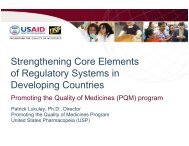Blood Pressure Classification
Blood Pressure Classification
Blood Pressure Classification
You also want an ePaper? Increase the reach of your titles
YUMPU automatically turns print PDFs into web optimized ePapers that Google loves.
<strong>Blood</strong> <strong>Pressure</strong> <strong>Classification</strong><br />
<strong>Blood</strong> <strong>Pressure</strong> <strong>Classification</strong><br />
BP <strong>Classification</strong><br />
SBP<br />
mmHg<br />
DBP<br />
mmHg<br />
Normal<br />
Relationship of Gender and Race/Ethnicity to BP<br />
Status in Adults ≥ 20 Years of Age<br />
Prehypertension<br />
(% prevalence)<br />
Hypertension<br />
Total US<br />
31.2<br />
29.8<br />
Male<br />
Female<br />
39.4<br />
22.9<br />
28.4<br />
30.5<br />
White<br />
African American<br />
Mexican American<br />
31.3<br />
29.8<br />
32.2<br />
28.4<br />
41.5<br />
28.0<br />
from Greenlund et al., Arch Int Med 2004; 164:2113-2118
Reasons for the Prehypertension Designation<br />
• The risk of CVD increases progressively from BP<br />
levels as low as 115/75 mm Hg upward. The<br />
incidence of CHD and stroke doubles for every<br />
20/10 increment of BP.<br />
• BP in most societies increases with age. In the<br />
Framingham Study, approximately 90% develop<br />
hypertension if live to ≥ 75 yrs.<br />
• More than two-thirds of prehypertensives have<br />
one or more other CVD risk factors.<br />
• The designation focuses attention on that segment<br />
of the population at increased CVD risk in whom<br />
healthy lifestyles may prevent or delay the onset<br />
of hypertension and CVD.
1976-98 98 Cumulative Incidence of Hypertension<br />
in Women and Men Aged 65 Years<br />
Risk of Hypertension %<br />
100<br />
Risk of Hypertension %<br />
100<br />
80<br />
Women<br />
80<br />
Men<br />
60<br />
60<br />
40<br />
40<br />
20<br />
20<br />
0<br />
0 2 4 6 8 10 12 14 16 18 20<br />
0<br />
0 2 4 6 8 10 12 14 16 18 20<br />
Years of Follow-up<br />
Years of Follow-up<br />
JAMA.2002;287:1003–1010.
Risk Factors for Hypertension<br />
•Prehypertension<br />
•Increasing age<br />
•Obesity<br />
•Positive family history<br />
•Black race<br />
•High dietary sodium/reduced potassium<br />
•Excessive alcohol intake<br />
•Low socioeconomic/educational status<br />
•Sleep apnea<br />
•Certain illicit drugs and over-the-counter<br />
meds
Advances in Treatment of Hypertension<br />
1940’s<br />
1950’s<br />
1960’s<br />
1970’s<br />
1980’s<br />
1990’s<br />
2000’s<br />
Potassium thiocyanate<br />
Kempner diet<br />
Lumbo-dorsal sympathectomy<br />
Rauwolfia/reserpine<br />
Ganglionic blockers<br />
Veratrum alkaloids<br />
Hydralazine<br />
Guanethidine<br />
Thiazide diuretics<br />
Methyldopa<br />
Spironolactone<br />
Beta-adrenergic blockers<br />
Alpha-1 adrenergic receptor<br />
antagonists<br />
ACE inhibitors<br />
Calcium antagonists<br />
Angiotensin receptor blockers<br />
Endothelin receptor antagonists*<br />
Renin Inhibitors
Summary of Clinical Trial Data on Effects<br />
of Antihypertensive Drugs on<br />
Cardiovascular Disease Incidence<br />
Effect of Rx<br />
vs. Placebo<br />
Stroke Incidence<br />
Coronary Disease Events<br />
Congestive Heart Failure<br />
35-40%<br />
20-25%<br />
40-60%
Benefits of Controlling Stage 1<br />
Hypertension<br />
• Sustained reduction of SBP by 12 mm Hg for<br />
10 years estimated to prevent 1 death for<br />
every 11 patients treated<br />
• In presence of CHD or other target organ<br />
disease, only 9 patients would require such<br />
sustained BP reduction to prevent 1 death<br />
from Ogden et al., Hypertension 2000;35:539
JNC Recommendations for an Initial<br />
Antihypertensive Agent<br />
Committee<br />
JNC 1<br />
JNC 2<br />
JNC 3<br />
JNC 4<br />
JNC 5<br />
JNC 6<br />
JNC 7<br />
Year<br />
1977<br />
1980<br />
1984<br />
1988<br />
1993<br />
1997<br />
2003<br />
Recommendation<br />
Thiazide-type diuretic<br />
Diuretic<br />
Thiazide-type diuretic or BB<br />
Diuretic or BB or CCB or ACEI<br />
Diuretic or BB<br />
Diuretic or BB<br />
Thiazide-type diuretic, either<br />
alone or in combination with<br />
ACEI, ARB, BB, or CCB<br />
BB indicates β blocker; ARB, angiotensin receptor blocker<br />
From Kotchen T, Hypertension 2006;48:196
Treatment and Control of High <strong>Blood</strong> <strong>Pressure</strong> in Adults<br />
Ages 18-74 (140/90 mm Hg)<br />
80<br />
70<br />
Awareness Treatment Control<br />
73<br />
70<br />
68<br />
60<br />
50<br />
51<br />
55 54<br />
59<br />
40<br />
30<br />
31<br />
29<br />
27<br />
34<br />
20<br />
10<br />
10<br />
0<br />
NHANES II NHANES III NHANES III NHANES<br />
1976-80 (Phase 1)<br />
1988-91<br />
(Phase 2)<br />
1991-94<br />
1999-2000<br />
NHLBI JNCVI 1999-2000 unpublished data
Recommended BP Targets for Therapy in<br />
Hypertensive Patients<br />
Group<br />
Without Co-morbidities<br />
Diabetes<br />
Chronic Kidney Disease<br />
Cardiac-related Conditions<br />
High CHD Risk<br />
Stable & Unstable Angina<br />
LV Dysfunction<br />
Stroke Secondary Prevention<br />
BP goal (mm Hg)<br />
< 140/90<br />
< 130/80<br />
< 130/80<br />
< 130/80<br />
< 130/80<br />
< 130/80<br />
< 140/90<br />
from JNC-7 and Rosendorff et al., Circulation 2007;115:2761
Relationship of Race/Ethnicity to<br />
Hypertension Control -- NHANES<br />
Control (
Physicians’ Attitudes in the Management of<br />
Isolated Systolic Hypertension (ISH)<br />
• Poor SBP control the major contributor to low<br />
rates of BP control<br />
• Most patients with ISH require 2 or more drugs to<br />
achieve BP control<br />
• Three-fourths of primary care physicians do not<br />
initiate BP therapy if SBP in the 140-159 mm Hg<br />
range. Most do not try to achieve SBP goal of <<br />
140 mm Hg<br />
• Many physicians continue to believe that control<br />
of DBP is more important than SBP
Important Priority Areas<br />
• Expand national public health efforts to<br />
promote lifestyle changes that reduce<br />
blood pressure and other CVD risk factors<br />
• Expand hypertension detection and<br />
treatment programs<br />
• Intensify education of clinicians on the<br />
importance of lowering systolic blood<br />
pressure



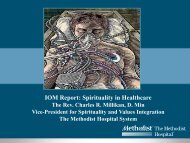


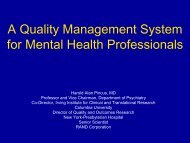
![Barry Davis Presentation.ppt [Read-Only] - Institute of Medicine](https://img.yumpu.com/31160415/1/190x146/barry-davis-presentationppt-read-only-institute-of-medicine.jpg?quality=85)
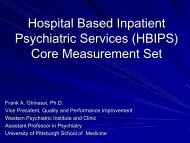
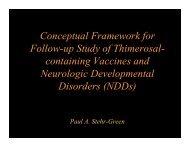
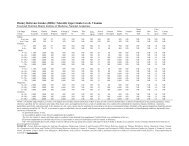



![Diekema.ppt [Compatibility Mode] - Institute of Medicine](https://img.yumpu.com/5085552/1/190x146/diekemappt-compatibility-mode-institute-of-medicine.jpg?quality=85)
